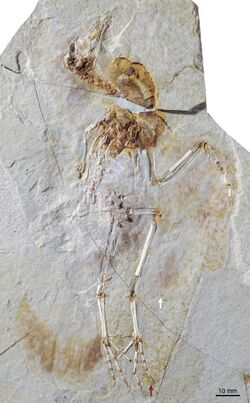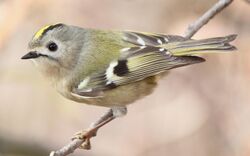Biology:Euornithes
| Euornithes | |
|---|---|

| |
| Fossil specimen of Hongshanornis longicresta | |

| |
| Goldcrest (Regulus regulus) | |
| Scientific classification | |
| Domain: | Eukaryota |
| Kingdom: | Animalia |
| Phylum: | Chordata |
| Clade: | Dinosauria |
| Clade: | Saurischia |
| Clade: | Theropoda |
| Clade: | Avialae |
| Clade: | Ornithothoraces |
| Clade: | Euornithes Stejneger, 1884 |
| Subgroups | |
| |
Euornithes (from Greek ευόρνιθες euórnithes meaning "true birds") is a natural group which includes the most recent common ancestor of all avialans closer to modern birds than to Sinornis.
Description
Clarke et al. (2006) found that the most primitive known euornithians (the Yanornithiformes) had a mosaic of advanced and primitive features. These species retained primitive features like gastralia and a pubic symphysis. They also showed the first fully modern pygostyles, and the type specimen of Yixianornis (IVPP 13631) preserves eight elongated rectrices (tail feathers) in a modern arrangement. No earlier pygostylians are known which preserve a fan of tail feathers of this sort; instead, they showed only paired plumes or a tuft of short feathers.[2]
Classification
The name Euornithes has been used for a wide variety of avialan groups since it was first named by Leonhard Stejneger in 1884.[3] It was first defined as a clade in 1998 by Paul Sereno, who made it the group of all animals closer to birds than to Enantiornithes (represented by Sinornis). This definition currently includes similar content as another widely used name, Ornithuromorpha, named and defined by Luis Chiappe in 1999 as the common ancestor of Patagopteryx, Vorona, and Ornithurae, plus all of its descendants. Because one definition is node-based and the other branch-based, Ornithuromorpha is a slightly less inclusive group.
Relationships
The cladogram below follows the results of a phylogenetic analysis by Lee et al., 2014:[4]
| Ornithothoraces |
| ||||||||||||||||||||||||||||||||||||||||||||||||||||||||||||||||||||||||||||||||||||||||||||||||||||||
The following cladogram below follows the results of a phylogenetic analysis by Pei et al., 2020:[5]
| Avialae |
| |||||||||||||||||||||||||||||||||||||||||||||||||||||||||||||||||||||||||||||||||||||||
Other genera
The following is a list of primitive euornithian genera and those that cannot be confidently referred to any subgroups, following Holtz (2011) unless otherwise noted.[6]
- †Alamitornis
- †Changmaornis[7]
- †Changzuiornis[8]
- †Dingavis[8]
- †Gargantuavis
- †Horezmavis
- †Iteravis[8]
- †Juehuaornis[8]
- †Platanavis
- †Wyleyia?
- †Yumenornis[7]
- †Xinghaiornis[8]
- †Zhyraornis
Note that Holtz also included the genera Eurolimnornis and Piksi as euornitheans, though they have since been re-identified as pterosaurs.[9]
References
- ↑ Min Wang; Xiaoting Zheng; Jingmai K. O’Connor; Graeme T. Lloyd; Xiaoli Wang; Yan Wang; Xiaomei Zhang; Zhonghe Zhou (2015). "The oldest record of Ornithuromorpha from the Early Cretaceous of China". Nature Communications 6: Article number 6987. doi:10.1038/ncomms7987. PMID 25942493.
- ↑ Clarke, Julia A.; Zhou, Zhonghe; Zhang, Fucheng (2006). "Insight into the evolution of avian flight from a new clade of Early Cretaceous ornithurines from China and the morphology of Yixianornis grabaui". Journal of Anatomy 208 (3): 287–308. doi:10.1111/j.1469-7580.2006.00534.x. PMID 16533313.
- ↑ Stejneger, Leonhard Hess (1884). "Classification of birds". The Illustrated Science Monthly 2: 45-46.
- ↑ Lee, Michael SY; Cau, Andrea; Darren, Naish; Gareth J., Dyke (2013). "Morphological Clocks in Paleontology, and a Mid-Cretaceous Origin of Crown Aves". Systematic Biology 63 (3): 442–9. doi:10.1093/sysbio/syt110. PMID 24449041.
- ↑ Rui Pei, Michael Pittman, Pablo A. Goloboff, Mark A. Norell, Stephen L. Brusatte, Xing Xu (2020). "Potential for Powered Flight Neared by Most Close Avialan Relatives, but Few Crossed Its Thresholds". Current Biology 30: 4033-4046. doi:10.1016/j.cub.2020.06.105. PMID 32763170.
- ↑ Holtz, Thomas R. Jr. (2012) Dinosaurs: The Most Complete, Up-to-Date Encyclopedia for Dinosaur Lovers of All Ages, Winter 2011 Appendix.
- ↑ 7.0 7.1 Wang, Y.-M. (2013). "Previously Unrecognized Ornithuromorph Bird Diversity in the Early Cretaceous Changma Basin, Gansu Province, Northwestern China". PLOS ONE 8 (10): e77693. doi:10.1371/journal.pone.0077693. PMID 24147058.
- ↑ 8.0 8.1 8.2 8.3 8.4 Huang, J., Wang, X., Hu, Y., Liu, J., Peteya, J. A., & Clarke, J. A. (2016). A new ornithurine from the Early Cretaceous of China sheds light on the evolution of early ecological and cranial diversity in birds. PeerJ, 4: e1765. doi:10.7717/peerj.1765
- ↑ Federico L. Agnolin; David Varricchio (2012). "Systematic reinterpretation of Piksi barbarulna Varricchio, 2002 from the Two Medicine Formation (Upper Cretaceous) of Western USA (Montana) as a pterosaur rather than a bird". Geodiversitas 34 (4): 883–894. doi:10.5252/g2012n4a10. http://www.mnhn.fr/museum/foffice/science/science/DocScientifique/publications/presentation/publicationAP/ficheContenu.xsp?CONTENU_ID=4592&PARUTION_ID=2966&PUBLICATION_ID=21&idx=6&nav=listeParution.





